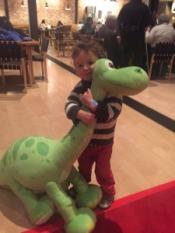Dinosaurs are Extinct, but Normalization is Alive and Well

This article was cross-posted on Disability Remix, the blog of the Paul K. Longmore Institute on Disability at San Francisco State University.
Lately, I’ve been learning a lot about dinosaurs. Or, I should say, my three-year-old son has been learning a lot about dinosaurs, and I have been caught in the crossfire. My mind is often churning to relate any new information I take in to my own passion of disability studies. I didn’t expect to find a link to dinosaurs… but I did.
Dinosaur science has advanced remarkably since my childhood. (Did you know, for example, that scientists now believe many dinosaurs had feathers?!)
But while our notions of what dinosaurs could have been is constantly evolving, we still cling to certain tenets of what I like to call “dinosaur normalization.” (I haven’t lexis-nexis’d it, but I think you just witnessed the birth of a completely original school of academic thought!)
Dinosaur normalization is the idea of prescribing what dinosaurs would have been like based on our own narrow worldview.
 For a quick example of dinosaur normalization, when scientists first discovered the Iguanodon (see right), they assumed he had a rhino-like horn on his nose. After further skeleton discoveries, it turns out the Iguanodon actually has two horn-like thumbs, something we’ve never seen before.
For a quick example of dinosaur normalization, when scientists first discovered the Iguanodon (see right), they assumed he had a rhino-like horn on his nose. After further skeleton discoveries, it turns out the Iguanodon actually has two horn-like thumbs, something we’ve never seen before.
But you don’t have to be an obscure dinosaur like the Iguanadon (that only three-year-olds and their parents are likely aware of) to be a victim of dinosaur normalization.
Here’s a children’s song about the stegosaurus:
My name is stegosaurus,
I’m a funny looking dinosaur….
My front two legs are very short.
My back two legs are long.
My body’s big, my head is very small
I’m put together wrong!
You know… a little judgmental. Plus, if the stegosaurus is “put together wrong,” isn’t that kinda our bad since we literally put them back together?
But even the almighty T-Rex is not spared from the hammer of normalization. There’s a general fascination with the T-rex’s tiny arms, each with two small claws. Many books ask: why did such a ferocious beast have such puny, useless arms? One fictional children’s film that I watched recently spent a solid 30 seconds joking at the t-rex’s expense.

When the newest movie in the Jurassic Park franchise was released, I was itching to see it for it promised a genetically modified dinosaur. I don’t condone genetic modification, but I thought this premise was brilliant, as it would allow the filmmakers to take all the scariest parts of dinosaurs and jam them together (which, inevitably, makes a really strong argument against genetic modification). Much to my surprise (and many other disappointed fans), the resulting dinosaur mostly just looked like a t-rex with longer arms and a full hand of claws. Sure, it had a few other hidden tricks but if you freeze-frame the film, that’s it. It’s as if there were a bunch of dino-fans who were sitting around saying, “I’m not afraid of the t-rex because its got those tiny arms. But if you had a t-rex with proportionate arms, well, now that’d be scary!”

There’s so much we are still learning about the t-rex. Scientists are now hypothesizing that the tyrannosaurus rex might not have made the ferocious roar we think of from the movies, but something more like a loud bullfrog croak. There’s also a lot of uncertainty about how fast the t-rex runs. Just yesterday even, an article announced the discovery of a pregnant t-rex, which is providing new data on egg-laying. So why aren’t we culturally more open to exploring what purpose the t-rex’s tiny arms might have served? The paleontologists are, but the children’s books and films don’t seem to be.
The disability rights movement pushes us to rethink our assumptions about how the body is supposed to look and what the body is capable of. Many disabled performance artists celebrate how their bodies are “put together wrong” to show us what the anomalous body can do once you embrace creativity and challenge bodily assumptions (see, for example, the many examples in Sins Invalid’s film An Unashamed Claim to Beauty). While the disability movement is pushing us away from normal, our dinosaur education for our kids lags behind.
Everything about dinosaurs is so totally not normal. When I stop and think about dinosaurs, the t-rex’s tiny arms and the stegosaurus’s small head seem so completely uninteresting compared to how bizarre it is that there were dinosaurs like this once living in North America:

Or knowing that this dinosaur-relative once swam in our oceans…yikes!

That our normalizing tendencies have extended to a species from over 65 million years ago shows us just how far our counter-efforts to take down normalcy must also go.
I’m going to encourage my kid not to think twice about the t-rex’s small arms. That’s just how they look, and from what we know about the t-rex (his FAVORITE dinosaur), they were pretty bad-ass, small arms or not.
*Believe it or not, this is actually the second blog by someone at the Longmore Institute with a connection to dinosaurs. Read the other, about Pixar’s access features in The Good Dinosaur, here.
####
Emily Beitiks is Associate Director of Paul K. Longmore Institute on Disability at San Francisco State University, and a former staffer at CGS. Beitiks earned her Ph.D in American Studies from the University of Minnesota with the dissertation "Building the Normal Body: Disability and the Techno-Makeover".
Images via Wikimedia, Creative Commons.



